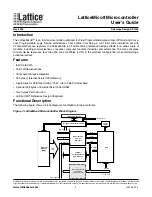
Functional Description
533
SLAU723A – October 2017 – Revised October 2018
Copyright © 2017–2018, Texas Instruments Incorporated
Internal Memory
7.2.1 SRAM
The internal system SRAM of the MSP432E4 devices is located at address 0x2000.0000 of the device
memory map. To reduce the number of time consuming read-modify-write (RMW) operations, Arm
provides bit-banding technology in the processor. With a bit-band-enabled processor, certain regions in
the memory map (SRAM and peripheral space) can use address aliases to access individual bits in a
single, atomic operation. The bit-band base is located at address 0x2200.0000.
The bit-band alias is calculated by using
.
bit-band alias = bit-band base + (byte offset × 32) + (bit number × 4)
(4)
For example, if bit 3 at address 0x2000.1000 is to be modified, the bit-band alias is calculated as:
0x2200.0000 + (0x1000 × 32) + (3 × 4) = 0x2202.000C
With the alias address calculated, an instruction performing a read/write to address 0x2202.000C allows
direct access to only bit 3 of the byte at address 0x2000.1000.
For details about bit-banding, see
.
NOTE:
The SRAM is implemented using four-way, 32-bit wide interleaved SRAM banks (separate
SRAM arrays). These SRAM banks allow for increased speed between memory accesses.
When using interleaving, a write to one bank followed by a read of another bank can occur in
successive clock cycles without incurring any delay. However, a write access that is followed
immediately by a read access to the same bank incurs a stall of a single clock cycle.
The SRAM layout allows for multiple masters to access different SRAM banks
simultaneously. If two masters attempt to access the same SRAM bank, the master with the
higher priority gains access to the memory bus and the master with the lower priority is
stalled by one wait state. If four masters attempt to access the same SRAM bank, access by
the master with the lowest priority is delayed by three wait states. The CPU core always has
the highest priority for SRAM accesses.
7.2.2 ROM
The internal ROM is at address 0x0100.0000 of the device memory map.
The ROM contains the following components:
•
Bootloader and vector table
•
Peripheral Driver Library for product-specific peripherals and interfaces
•
AES cryptography tables
•
CRC error detection functionality
The bootloader is used as an initial program loader (when the flash location 0x0000.0004, the reset vector
location is 1s [that is, erased state of flash]) and as a firmware upgrade mechanism that is application-
initiated (by calling back to the bootloader).
The Peripheral Driver Library APIs in the ROM can be called by applications, reducing flash memory
requirements and freeing the flash memory to be used for other purposes (such as additional features in
the application).
AES is a publicly defined encryption standard used by the U.S. government.
CRC is a technique to validate whether a block of data has the same contents as when previously
checked.
NOTE:
CRC and AES software programs are available for backward compatibility. A device that has
enhanced CRC and AES integrated modules should use this hardware for best performance.
See
and
for more information.
















































